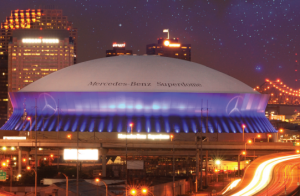Editor’s note: The following team-by-team capsule reports of NFL stadium technology deployments are an excerpt from our most recent Stadium Tech Report, THE PRO FOOTBALL ISSUE. To get all the capsules in one place as well as our featured reports, interviews and analysis, download your free copy of the full report today.
NFC SOUTH
Reporting by Paul Kapustka
 New Orleans Saints
New Orleans Saints
Mercedes-Benz Superdome
Seating Capacity: 76,468
Wi-Fi – Yes
DAS – Yes
Ten years after Hurricane Katrina devastated New Orleans, the Superdome remains a signal of the region’s recovery. Inside the dome, the Wi-Fi installed before the most recent Super Bowl there is still going strong.
Atlanta Falcons
Georgia Dome
Seating Capacity: 71,280
Wi-Fi – Yes
DAS – Yes
Even as they wait for the technological wonder that is the coming next year at Mercedes-Benz Stadium (with fiber-based Wi-Fi from IBM and Corning), Falcons fans still have way better than average connectivity inside the Georgia Dome, where a Cisco-powered network provides access to mobile treats like instant replays from multiple camera angles.
Carolina Panthers
Bank of America Stadium
Seating Capacity: 74,455
Wi-Fi – Yes
DAS – Yes
Bank of America Stadium completely replaced its DAS solution during the offseason with a new Commscope ION-U system. The new DAS is owned by the Panthers directly and includes Verizon, AT&T, and Sprint as participants. Look for the stadium to completely replace its Wi-Fi system this coming offseason, with a new 1,200-AP network for the 2016 season.
Tampa Bay Buccaneers
Raymond James Stadium
Seating Capacity: 65,890
Wi-Fi – Yes
DAS – Yes
Raymond James Stadium got free fan-facing Wi-Fi for the 2012 season, but since then we haven’t heard anything about upgrades to the system. With the college playoff championship game coming in 2017, however, you can probably expect to see connectivity improvements coming soon.






